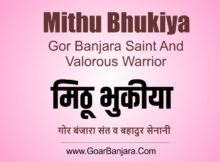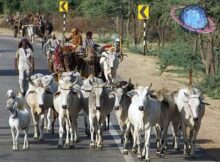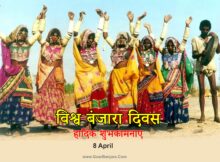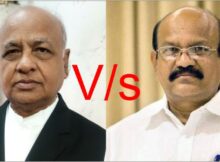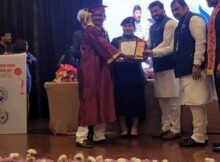There are many freedom fighters from the Gor Banjara community who fought against the British rule. After the arrival of railways in India, the Gor Banjara tribe’s dominance of Ladeni trading came to an end. The important social reformer and freedom fighter was led by Govind Guru Banjara, who was born in the Gor Banjara tribal community. But due to the lack of education in the Banjara community, Banjaras’ history remained unknown, our authors could not write revised writing on these subject. The most prominent Gor Banjara freedom fighters are considered Govind Guru Banjara and Saint Mithu Bhukiya. Herewith I am giving historical details for your information in both Hindi and English language.
Mithu Bhukiya was a Gor saint, who lived in different places in different states. Gor Banjara believed that he had the blessings of Goddess Jagadamba and similar evidence is found that he performed miracles like Saint Seva Bhaya. He spent most of his life in a Tanda of Go Banjara in Parbhani district in Marathwada region of Berar province and in the last phase of his life and he came to Andhra Pradesh and established Mithu Bhukiya Tanda at a place called Pulaguttanalla between Guntakal and Gooty in Anantapur district. He was one of the four leaders of the Gor
Banjaras, who lived in the colonial period. During the period, Gor Banjara was leading the Ladeni tradings.

The three other leaders were Bhima Zharpla, Devla Naik and Rupala Naik. Mithu Bhukia is revered among the Banjaras as the god of power and fortune. It is said that he was respected by the Banjara dacoits because a hut was usually set up for him in the history of the Banjara community, a white flag was placed before his hut. Before setting out for the robbery, people gathered in Mithu Bhukia’s hut and lit lamps to ask for an omen If lamp- Deepak’s wick had dropped Shagun, he would come back home, raiding at once. They could not talk to each other. The challenge was that, if anyone spoke, the attraction would break, and the protection of Mittu Bhukya would be removed, and they would either have to return, retake the omen, or that particular robbery. It was necessary to leave completely. It is recorded as a feature of the Banjaras, that they adopted it as a rule, not as an answer, if it was to be involved in plunder and custom, it was probably necessary to follow it.
But the worship of Meetu bhukia is often neglected. After succeeding in the dacoity, a portion of the robbers had to be set aside for Mitu Bhukia. And of the balance, Nike (Headman) would receive two shares if he was involved in the crime. The man who gave the first push or did the most work for the common object got two shares and everyone else got one share each. The portion that Mithu Bhukia got, was used as a feast for all the participating men. For the success of the robbery, incense is burned in his hut and liquor poured over the flagstaff. A portion of the food sent to women and children was set aside and then the men were scheduled to feast. Women were not allowed to worship Mithu Bhukia or enter his hut.
The mythological story states that Gor Banjara once looted Rampur. This is a place in Parbhani district of Berar province. At that time, Parbhani was under the Muslim ruler and sent four of his soldiers to Rampur to inquire about the sting bells and those involved in the looting. The soldier came to Devla Naik and told that the emperor ordered the people involved in the looting organized at Rampur to capture them as enemies. Immediately, Devla Naik gathered thousand people and went to the emperor, with the emperor alleging that Devla Naik and his followers had looted Rampur. As Devla Naik strongly opposed the allegations by the emperor and said that this is not a true incident.
But the emperor was not convinced by the explanation given by Devla Naik and he was asked to prove that they were not involved in the looting and the emperor believed that if he failed to prove his innocence, he would get the iron heat rod and will hurt all people’s palms who were participants in the inquiry. And if their hands are burnt, they are thieves and if it not, they will be considered as they are not involved in the theft. Devla Naik tells emperor that he is ready to undergo this test and he returns to Tanda with his followers. But Devla Naik was afraid of the condition made by king as they are not to get involved in the theft. Afterwards, Devla Naik met Meethu Bhukiya and requested him to save them. And Considered that if Mithu Bhukiya saves them, they will worship him forever. Mithu Bhukiya reassures Devla Naik and says that he will take care that his hands will not not burn by emperor with hot iron rods. As per the time given by the emperor, they went to him for trial.
When they were tested by the emperor with hot iron rods on their palms, to the surprise of Devla Naik and his followers, they experienced their palms not burning with the hot rod held by the emperor. And the last man threw an iron rod on a pile of wood which caught fire all around. Then it appears that Devla Naik asked the emperor to behead him. But the emperor apologized to Devla Naik and his followers. They returned home safely and then started worshiping Mithu Bhukiya.
Since the history of the Gor Banjara heroes has not been written, most of their heroic activities are not available in real writings. And elsewhere events of their heroic and spiritual leadership are verbally practiced in Banjaras’ folk literature. As Mithu Bhukia was their social reformer and religious guru, whom they considered him hero and distinguished him as their spiritual master. Unfortunately, during the British rule, though he was considered a criminal.
Under British colonial rule, the criminal stigma associated with the Gor Banjara tribal community pushed them into surveillance, arrest and detention by British authorities, regardless of who committed the crime. Criminality was forcefully applied to certain tribal groups and was considered a born criminal and was recognized as a criminal tribe in the Criminal Tribes Act ‘1871 (CTA).
When robberies occurred during the famine, Gor Banjara were suspected of being a criminal and so they faced criminal action by the authorities. Poor and innocent people were arrested and harassed to live in the community. They were declared as a criminal and persecuted the community as a crime and robbery, even though they had never participated in any robbery.
Cumberlage, N.R. was the District Superintendent of Police at Berar, he has described the rituals of worshiping the deities of the Gor Banjars and has tried to suggest a connection between them and the robbery possession. According to him other criminal tribes worshiped Mahakali; Gor Banjara worshiped in a Kali temple at a place called Pohra. And another deity was worshiped in which Mithu Bhukia is considered, whom it is believed to have lived in the Central Province and were worshiped only by dacoits, as the smartest, never found dacoits were entrusted by their ancestors. Hierarchy (in terms of caste, class, gotra and tribe) among the Gor Banjara class carried out by the British authorities.
The Duke of Wellington (1910) stated that the Charan Banjara did not allow infant marriage; They worship Mariyama Devi, and the famous Mithu Bhukiya, for whom in almost every Tanda a hut was separated with a white flag. Like Robin Hood, of English folklore was an extroverted hero. He was an incomparable archer and skilled swordsman who is known even today, along with his fellow “Merry Mens”, to loot the wealth of the rich and distribute it among the poor. Similarly, Mithu Bhukia has been accused of ‘Gor Banjara Robin Hood’ by the British without any reason. Along with alcohol and a special male-goat, it is considered a custom to worship him. Ever since a section of the Gor Banjars committed robbery during the colonial period, they have been worshiping Mithu Bhukiys as even in modern times. There are many untold stories about the Banjara saint Mithu Bhukiya, narrated by the Banjara people, it is needed to collect and explore the more writings to get more information about the real history of Banjars community.
Bibliography:
❖ Cheeniya Nayak B., “Banjara Charitra, Samskruti, Pragati”, Hathiram Bawaji Publication, Aravindnagar, Anantapur, 2001
❖ Cumberlege, N. R., ‘Some Account of the Bunjarah Class’, Bombay, 1882. The Central Provinces District Gazetteers (Facsimile reproduction). Duok District, Volume A, originally published in 1910,
❖ Gazetteers Department, Government of MH official website, retrieved from https:/ maharashtra.gov.in
❖ R.V. Russell and Lal, “The Tribes and Castes of the Central Provinces Macmillan and Co. Pub, Limited, London, 1916
❖ Dhananjay Surya- Gor-Banjara An Enduring Tribe
❖ Manisha Choudhary, Trade, Transport and Tanda Shifting Identities of the Banjaras. Manohar Publishers & Distributors, New Delhi
❖ As narrated by Tanda’s aged people
Compiled By-
Prof. Dr. Dinesh Sewa Rathod
profdineshrathod@gmail.com
Mob- +91 940437275
Read PDF E-Book>>> Download






